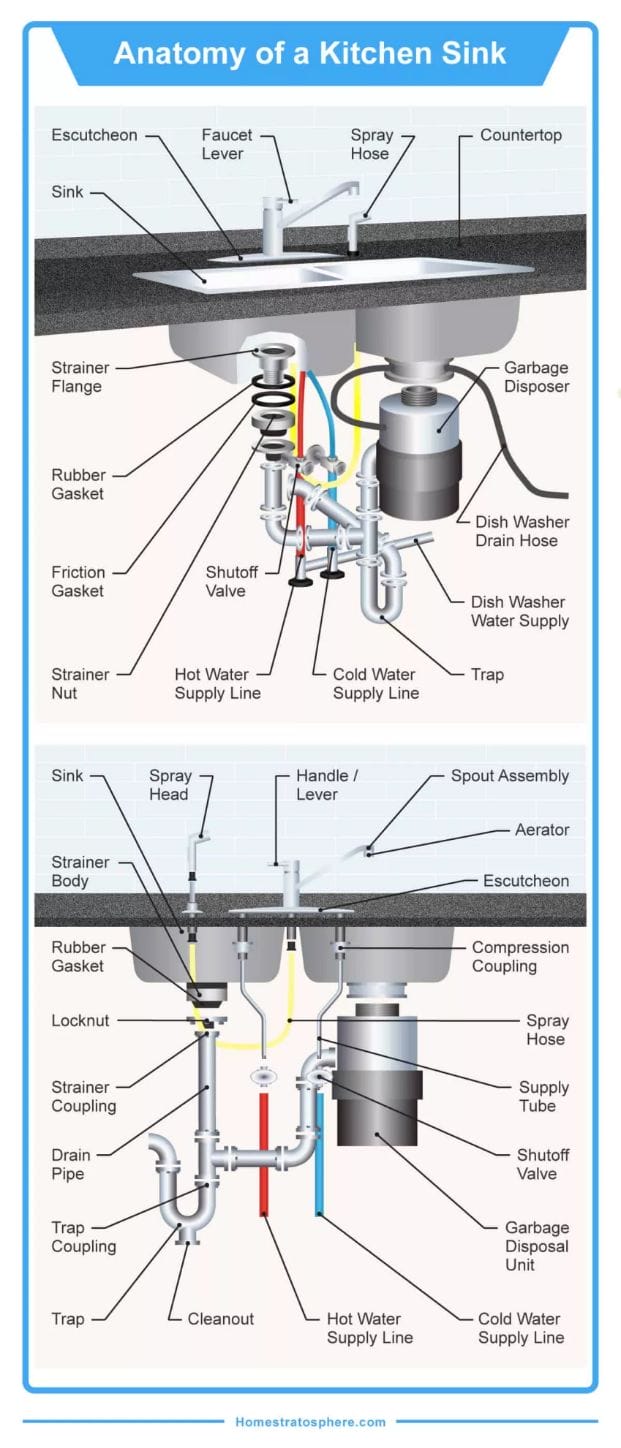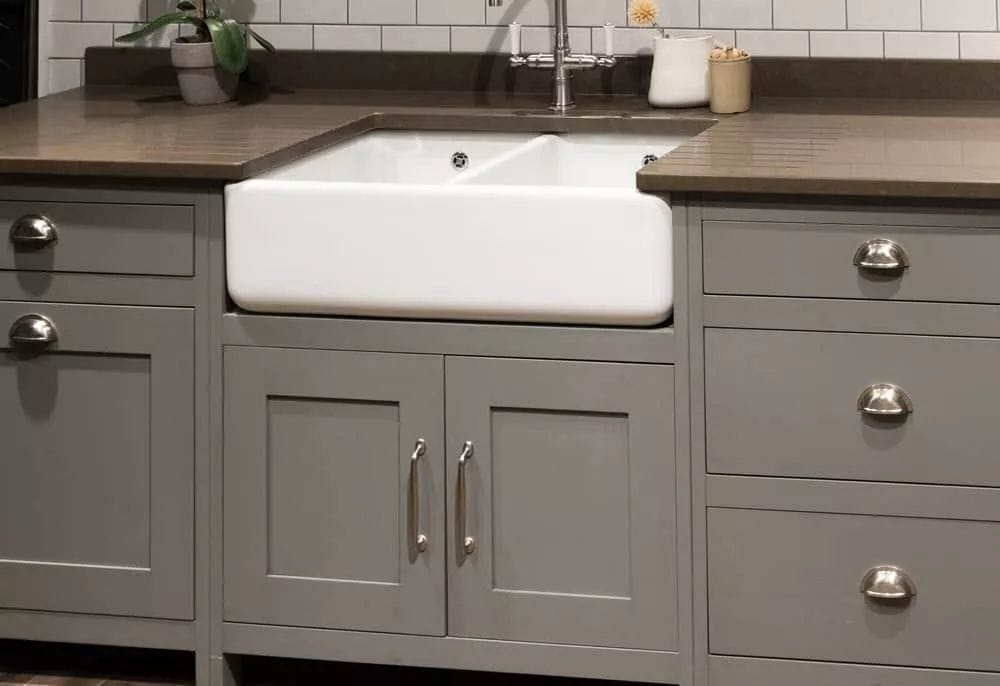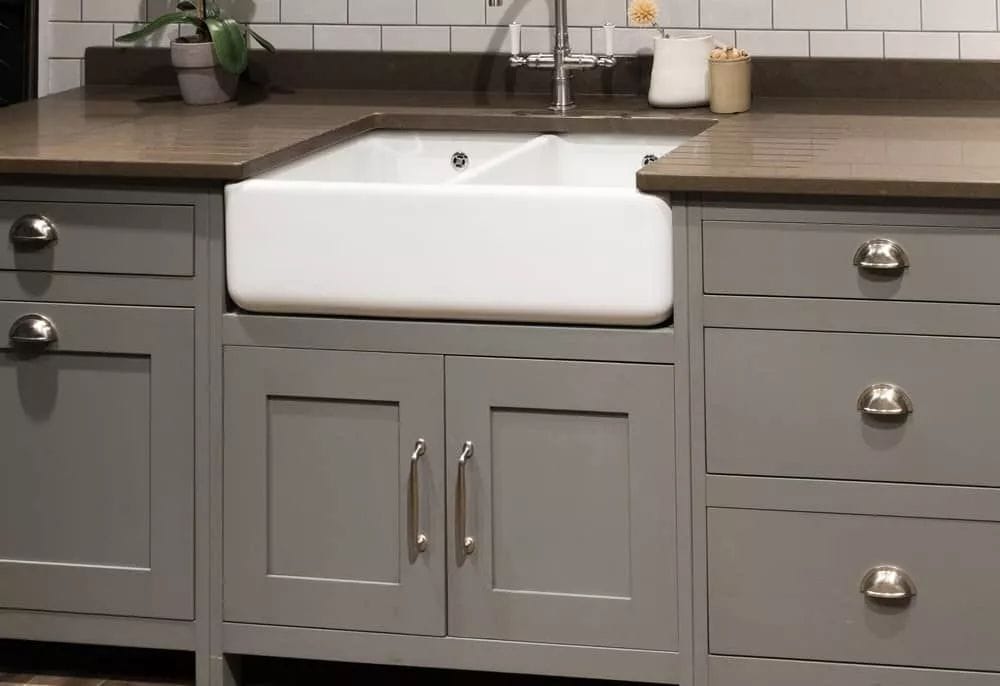As a homeowner, it’s better to recognize and understand the kitchen sink parts in detail. It will come in handy when you find a problem with one of them that hinders your housework.
The problem may come in various ways. It might be the drains are clogged or the water flowing out of the faucet is not as smooth as usual, making you need a little repair or even a full replacement for the new one.
But don’t worry, because the problems that are not too severe will be able to solve yourself quickly without requiring you to have specific skills.
Moreover, today, everything seems to be straightforwardly resolved by following the DIY project on YouTube or such kind of article explanations.
Now, instead of calling a professional plumber, you can confidently fix them yourself at home by identifying all the most essential kitchen sink parts properly.
Besides saving enough time, it will also help you save on your monthly expenses.
Kitchen Sink Parts Diagram to Guide You Understanding the Dish Washer Anatomy Properly

Not many people aware that there are quite a lot of kitchen sink parts that support the creation of this dishwasher.
While some of them are the most important ones that you should know well—starting from the kitchen sink plumbing, a strainer to the faucet.
This article provides a kitchen sink parts diagram coupled with detailed explanations for each part to make it easier for you to understand.
Below are the twenty-five wash basin sink parts names that you should know. Without further ado, let’s find out those parts.
What Are the Parts of a Kitchen Sink Called?

1. Countertop
A countertop is one of the many kitchen sink parts that has a flat surface surrounding your washbasin. Usually, this section is made of soapstone, marble, or granite, which functions as the washing space’s working area.
2. Sink
Once talking about the sink, this section also comes with several nicknames, namely washbasin, sinker, hand-basin, and wash-bowl.
A sink is a bowl-shaped plumbing fixture that usually functions to hold water flow and all the items you washed. Apart from washing dishes, this is also a spot for cleaning vegetables, fruits, etc.
Overall, it is one of the essential parts of all existing kitchen sink parts.
3. Escutcheon
The escutcheon is one of the few parts of a kitchen sink faucet. It looks like a plate made of metal around the tap feature that functions to cover the holes of pipes and valves.
Usually, this section is also called the cover plate. Apart from protecting the pipe and valve holes, escutcheon also has an aesthetic function for a tidier installation.
4. Faucet Lever
The lever is one of the kitchen sink parts that is often found attached to an integral part of the faucet itself. However, several models install it separately.
The faucet lever functions to control water flow, which will later come out through the spout.
In general, faucet levers are made of various materials such as stainless steel, plastic, brass, and zinc.
5. Spray Hose
The spray hose is one part of the tap features that connect or direct the faucet’s water supply. Usually, this part will be easily visible on the pull-out kitchen faucet.
Or, for its other remaining parts, you can see it under your washbasin.
6. Trap
The trap is one of several kitchen sink parts located at the bottom of the washbasin, which has a P-like shape. In general, this device functions to prevent sewer gases from entering the house and traps the dreck.
7. Dish Washer Water Supply
The dishwasher water supply is a device at the bottom of the sink that functions as a line for clean water, later sprayed through the faucet.
8. Dish Washer Drain Hose
The dishwasher drain hose is one of several kitchen sink parts that pumps or direct wastewater to the garbage disposal. Usually, if there is a problem with this component, the remaining water in your basin will stagnate.
So, when that happens, try to check what’s clogging this line so that the drainage flow returns to normal.
9. Garbage Disposer
Garbage disposer or some call it disposal, is a device that resembles a chamber that functions to grind out food scraps that have a solid texture.
In this component, all the kitchen refuse is pulverized to be safer and does not clog the kitchen sink drain parts.
Among the many kitchen sink parts available, garbage disposer is the heart of all your food waste ends. To find it, you can look at the bottom side of the wash-bowl where it is installed between the trap and drain.
10. Shutoff Valve
The shut-off valve, also known as the cut-off and stop valve, is a feature that is located beneath your kitchen sink, usually right at your water supply line.
This fixture functions to control water flow to the faucet, especially when you need to use the appliance when reparation is being made.
When you turn it off, the water supply flow will also stop, and it will not reach your sink.
11. Kitchen Sink Strainer Flange
One of the many kitchen sink parts installed inside the washbasin comes first with the strainer flange.
What is a sink flange? It is a flat metal disk connected to a strainer body. This fixture serves to hold the drain to remain attached to the washbowl.
Usually, you can see this sink fixture in the middle of the basin surface, and it will be easy to spot with just one look.
12. Strainer Body
If you are really curious about what is the thing under the sink called? Then the answers will be varied.
Nevertheless, the strainer body was the first to come. This component is one of the kitchen sink parts that play a role in filtering debris since you start washing your dishes.
This filtering process is useful so that no large size food waste enters the water system. And it prevents the drain clogging problems.
13. Rubber Gasket
Rubber gaskets are another essential element of many kitchen sink parts that you can encounter. It is a seal that protects the barriers on two different surfaces on the dish washer set.
In particular, the rubber gasket will be able to prevent leakage of liquid or gases from the sewer into your home.
14. Friction Gasket
It is the barrier referred to in the previous explanation. You can find this friction gasket after you disassemble the strainer parts at the bottom side of your sink.
Precisely the friction gasket is located between the rubber and the strainer nut. This component acts as a protective barrier, which becomes antifriction between the two moving surfaces.
As a result, the locknut will be tightly attached.
15. Hot Water Supply Line
The hot water supply line is one of the kitchen sink parts that functions to control the water flow that comes out of the faucet, especially for the warm ones.
It will be relatively easy to find this component. In general, the hot water supply line installation is on the left, while the cool one is on the right side.
16. Cold Water Supply Line
By system, the cold-water pipe has the same function as the hot water supply line. That is to regulate the water flow from the primary water source to the faucet on the surface of your dishwasher.
The difference between the cold-water supply line with the hot one is only in the temperature of the flow it carries. You can find it under the sink between the plumbing on the right side for its common location.
17. Aerator
The aerator is one of the kitchen sink parts attached to the faucet head.
If you pay attention to your tap in detail, you will be able to find a disc with fine holes resembling a filter. This faucet fixture functions to regulate water flow into many small streams to avoid the basin’s heavy flow and spurt.
Moreover, this aerator can also reduce the volume of water flowing through your faucet gradually.
18. Faucet Handle/Lever
All fixtures in the kitchen appliance need a handle or lever to control their usage. Be it the lamps, ovens, and stoves, likewise, with the kitchen sink.
In general, the faucet lever is easily known as a controller that functions to turn on and off the water flow in your dishwasher system.
Without this element, it would not be effortless to handle the water streams once you have to wash the dishes.
19. Spout Assembly, the Most Eye-catching Fixture among Other Kitchen Sink Parts
One of the kitchen sink parts that you can also find quickly is the spout assembly. The location of this fixture is very prominent, indeed, on your faucet kit.
Spout assembly is the component that channel the water flow from the washbasin’s body into the surface area. It is also the part where you can find an aerator.
Spouts assembly comes in many designs, ranging from straight and simple style to ones with a gooseneck shape.
20. Spray Head
The spray head is one of the kitchen sink parts with a function almost the same as the faucet spout, which is to spray the water streams to the basin surface.
Some things that make the spray head slightly different from the spout faucet are function, flexibility, and ability to reach the washbowl’s area.
If the spout kit is a fixed, embedded kitchen sink fixture, then the spray head is another component that can be pulled out and can reach a wider area.
Moreover, the faucet spout usually becomes the standard fixture used to wash dishes, hands, fruit, and vegetables. In contrast, the spray head is more for cleaning the area around the washbasin.
21. Supply Tube
This is one of the devices that can connect the water supply to the faucet surface. It is known as a supply tube. In appearance, this fixture has a similar shape and size as the drain hose. But it is indeed a different fixture.
Commonly, you can also find this component at the bottom part of your wash-bowl.
22. Locknut
Try observing your kitchen strainer once more.
If you find a device with a round shape located right at the bottom of the strainer cup, it is called a locknut or spud nut.
The locknut is a fixture that functions to tighten the drain basket part with other connected surfaces beneath. The locking that has been done by this component can prevent the drain parts from leaks.
23. Cleanout
Cleanout is one of the most helpful kitchen sink parts. Through this pipeline, you can quickly identify any problems that clog the dishwasher water system.
Apart from helping to fix blockages from dirt, you can also check your drain line condition through this cleanout component.
24. Drain Pipe
According to the kitchen sink drain plumbing diagram above, you can find out that the drainpipe is a dishwasher component with a long tube shape installed under your washbasin.
This section has a role in carrying out wastewater and sewage from your washing process out of your house.
Besides, the drain pipe also functions to regulate the air pressure in your plumbing system so that it can avoid clogging. In general, these components are usually made of metal or plastic.
25. Compression Coupling
Last but not least, from many kitchen sink parts comes a compression coupling or fitting. It is a device that connects two pipes or a pipe with other elements such as a shutoff valve or other under sink fixtures.
In general, the compression coupling has three parts arranged in sequence from top to bottom, namely the compression nut, ring, and seat.
Final Thought
Learning to know the kitchen sink parts in detail will help you understand each device’s functions better.
Besides making it easier to carry out everyday maintenance, understanding the kitchen sink parts can also help you repair your dishwasher yourself confidently once the problems are found.
As a result, you will be able to save more money for other household needs. In addition, you can also buy some kitchen sink parts and store them at home. Just in case if suddenly your sink broken.
